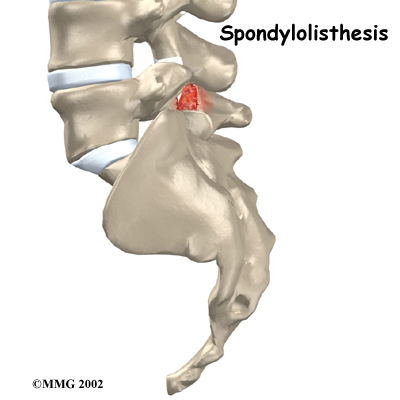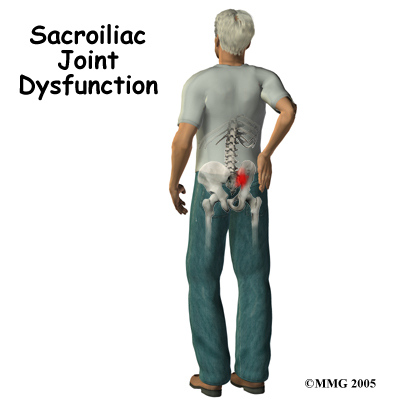
Low Back Pain
Low back (lumbar) pain is one of the main reasons people visit their doctor. For adults over 40, it ranks third as a major issue—after heart disease and arthritis— that necessitates medical treatment.

Piriformis Syndrome
Pain in the buttock that radiates down the leg is commonly called sciatica. The most common cause for sciatica is irritation of the spinal nerves in or near the lumbar spine. Sometimes the nerve irritation is not in the spine but further down the leg. One possible cause of sciatica is piriformis syndrome. Piriformis syndrome can be painful, but it is seldom dangerous and rarely leads to the need for surgery. Most people with this condition can reduce the pain and manage the problem with simple m...

Lumbar Spondylolysis
Spondylolysis happens when a crack forms in the bony ring on the back of the spinal column. Most commonly, this occurs in the low back. In this condition, the bone that protects the spinal cord fractures as a result of excessive or repeated strain. The area affected is called the pars interarticularis, so doctors sometimes refer to this condition as a pars defect.

Lumbar Spondylolisthesis
Normally, the bones of the spine (the vertebrae) stand neatly stacked on top of one another. Ligaments and joints support the spine. Spondylolisthesis alters the alignment of the spine. In this condition, one of the spine bones slips forward over the one below it. As the bone slips forward, the nearby tissues and nerves may become irritated and painful.

Lumbar Spinal Stenosis
According to the North American Spine Society (NASS), spinal stenosis describes a clinical syndrome of buttock or leg pain. These symptoms may occur with or without back pain. It is a condition in which the nerves in the spinal canal are closed in, or compressed. The spinal canal is the hollow tube formed by the bones of the spinal column. Anything that causes this bony tube to shrink can squeeze the nerves inside. As a result of many years of wear and tear on the parts of the spine, the tissues...
Lumbar Facet Joint Arthritis
Arthritis of the lumbar facet joints can be a source of significant low back pain. Aligned on the back of the spinal column, the facet joints link each vertebra together. Articular cartilage covers the surfaces where these joints meet. Like other joints in the body that are covered with articular cartilage, the lumbar facet joints can be affected by arthritis.

Lumbar Disc Herniation
Although people often refer to a disc herniation as a slipped disc, the disc doesn't actually slip out of place. Rather, the term herniation means that the material at the center of the disc has squeezed out of its normal space. This condition mainly affects people between 30 and 40 years old.

Lumbar Degenerative Disc Disease
The intervertebral discs in the lower spine are commonly blamed for low back pain. Yet low back pain has many possible causes, and doctors aren't always certain why symptoms occur.

Adult Degenerative Scoliosis
A normal healthy spine will be straight when seen from the front or the back. When seen from the side, the normal spine forms a gentle S curve.

Spinal Compression Fractures
Compression fractures are the most common type of fracture affecting the spine. A compression fracture of a spine bone (vertebra) causes the bone to collapse in height.

Sacroiliac Joint Dysfunction Patient Guide
A painful Sacroiliac (SI) joint is one of the more common causes of mechanical low back pain. A ‘dysfunction’ of the SI joint is a term that is used to describe the pain associated with this joint because it is often still unclear why this joint becomes painful and leads to low back pain. Most people who suffer from this problem can reduce the pain with physiotherapy treatment and manage the problem.

Sacroiliac Joint Injections
Sacroiliac (SI) joint injections are primarily diagnostic injections, meaning that they help your health care professional delineate the cause of your back pain. They may also be used to give temporary pain relief if you suffer from chronic SI joint pain but the injections do not usually eliminate the pain and they may not provide prolonged pain relief. These injections temporarily assist the pain by filling the SI joint with an anesthetic medication that numbs the joint, the ligaments, and th...

Spondyloarthropathies
There are many different types of rheumatological diseases that affect the spine. A rheumatological disease is a problem that affects the entire body as a whole, rather than just one joint, such as the relatively well-known rheumatoid arthritis. When a rheumatological disease affects the spine, the resulting conditon is called a spondyloarthropathy. The term is made up of the Greek words: "Spondylo" meaning "vertebra," "arthro" meaning "joint," and "pathos" meaning "disease."

Sacroiliac Joint Dysfunction
A painful sacroiliac joint is one of the more common causes of mechanical low back pain. Sacroiliac (SI) joint dysfunction is a term that is used to describe the condition - because it is still unclear why this joint becomes painful and leads to low back pain. Sacroiliac joint dysfunction can be a nuisance but it is seldom dangerous and rarely leads to the need for surgery. Most people who suffer from this problem can reduce the pain and manage the problem with simple methods.

Sacral Insufficiency Fractures
The sacrum is a wedge shaped bone that makes up part of the pelvis. It transmits the weight of the body to the pelvic girdle. As the name suggests, sacral insufficiency fractures occur when the quality of the sacral bone has become insufficient to handle the stress of weight bearing. The bone has lost some of its supporting structure and has become weak. Since this is usually because of osteoporosis, sacral insufficiency fractures occur most often in older women.

Nutrition and Your Spine
You are what you eat. Is that simply a funny saying or is there some truth to that old adage? The spine is not something that usually comes to mind when one thinks about nutrition - but it should. Nutrition is important in having a healthy spine. Good nutrition also helps control pain and disability when we are suffering from many different types of spine conditions. This guide will help you understand:






